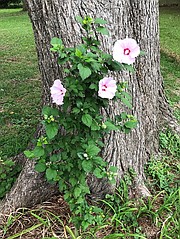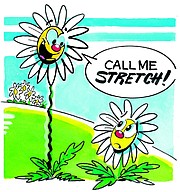Q I planted Shasta daisies from seed last year, and they did great. This year they got very tall and gangly and died. I did not water much, but they survived drier conditions last year.
A It is possible your plant had a disease, or something could have eaten the roots or damaged the crown of the plant. Shasta daisies are susceptible to a disease called verticillium wilt, which is a soil-borne disease. In many cases, symptoms do not develop until the plant is flowering or after periods of stressful hot, dry weather. Older leaves usually develop symptoms, which include yellowing, wilting and eventually dying and dropping from the plant. Infected leaves can also develop pale yellow blotches on the lower leaves. It can lead to the death of the plant. If you still have the plants, cut into the stem at the soil line and see if there is brown streaking inside. Or take the roots and stem to your local county extension office; they can send it to the University of Arkansas Cooperative Extension Service disease diagnostic lab.
Q I have tried to root some fig tree cuttings and plum tree sprouts from the yard of our old family home to try to move them to a new residence. I have had a lot of success over the summer in doing this, and they have almost all grown and developed well. However, there is no place to plant them yet this fall in the new location. I have the new plantings in 12-inch pots outside. Should I leave them outside over the winter in these pots or bring them inside my current residence over the winter, or should I re-pot them into larger pots now, leave them outside over the winter, and mulch around them? Any advice would be really appreciated.
A Neither figs nor plums would be happy inside, but in pots they will need some protection and care this winter. If you have shrubs at the new location, you can group all of your rooted plants together (either in their current pots or upgraded to the next size up) next to the foundation of your house between the house and the shrubs. This is a more protected site. Add mulch or straw around the base of the pots as winter approaches. Pay attention to water needs this winter, particularly before a hard freeze. An added light layer of mulch after they have gone dormant can also help them survive. Another option would be to store them in a garage or in a crawl space under the house after they have gone dormant.
Q What is this plant growing next to our elm tree? [The reader sent a photo.] It has had many beautiful pink (sometimes white or purple) blooms on it this year. I'm sending a photo of the plant and seed pods. It has been growing there several years.
A You have a seedling rose-of-Sharon or althea bush growing next to your elm tree. It is obviously happy as it is loaded with blooms. If you want to move it somewhere where it has more room to grow, doing so this fall would be ideal.
Q I have not been out in my garden for a bit, and I noticed this weekend that a few of my azaleas are almost white in appearance. Is this some type of mildew? What should I do about it now?
A Your azaleas have one of the most common insect problems they get -- azalea lacebugs. Lacebugs are small insects with lacelike wings that begin attacking azaleas in May. If left unchecked, there can be multiple generations of the insects. As they feed on the under surface of the leaf, they pierce the leaf and suck out the plant sap. Early feeding shows a few specks of white on the upper leaf surface where the plant juice has been removed. Heavy feeding allows all the specks to merge together and appear silvery or gold in appearance. The under surface of the leaf will have black and brown specks and feel gritty. Adult and immature insects will be feeding side-by-side but are very tiny and hard to see with the naked eye unless you look closely. It is too late in the season to use any chemicals to control them, but monitor for damage next spring. Systemic insecticides work best, used in May and June.
Janet B. Carson is a horticulture specialist for the University of Arkansas Cooperative Extension Service. Write to her at 2301 S. University Ave., Little Rock, Ark. 72204 or email her at
jcarson@arkansasonline.com
HomeStyle on 10/06/2018

